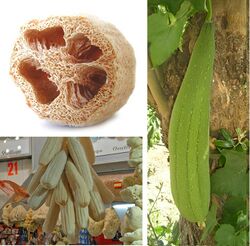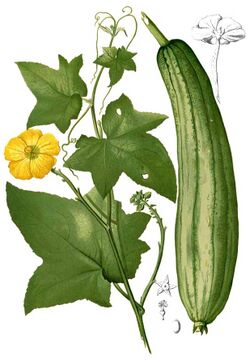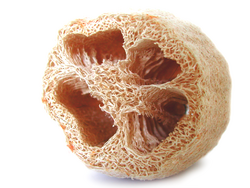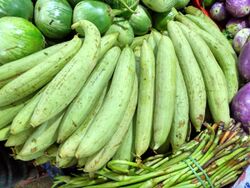Biology:Luffa aegyptiaca
| Luffa aegyptiaca | |
|---|---|

| |
| Egyptian luffa fruit | |
| Scientific classification | |
| Kingdom: | Plantae |
| Clade: | Tracheophytes |
| Clade: | Angiosperms |
| Clade: | Eudicots |
| Clade: | Rosids |
| Order: | Cucurbitales |
| Family: | Cucurbitaceae |
| Genus: | Luffa |
| Species: | L. aegyptiaca
|
| Binomial name | |
| Luffa aegyptiaca Mill.
| |
| Synonyms[1] | |

Luffa aegyptiaca, the sponge gourd,[2] Egyptian cucumber or Vietnamese luffa, is an annual species of vine cultivated for its fruit, native to South and Southeast Asia.
Description
The three-lobed leaves are 7.5–20 centimetres (3–8 inches) wide.[3]
The fruit, approximately 30 cm (12 in) long and maturing to brown, resembles a cucumber[3] in shape and size.
History
Etymology
The synonymous botanical specific epithet "aegyptiaca" was given to this plant in the 16th century when European botanists were introduced to the plant from its cultivation in Egypt. In the European botanical literature, the plant was first described by Johann Veslingius in 1638, who named it "Egyptian cucumber". Veslingius also introduced the name "Luffa".[4]
Composition
Nutrition
| Nutritional value per 100 g (3.5 oz) | |
|---|---|
| Energy | 56 kJ (13 kcal) |
14.34 g | |
| Sugars | 5.17 g |
| Dietary fiber | 2.9 g |
0.34 g | |
0.66 g | |
| Vitamins | Quantity %DV† |
| Vitamin A | 260 IU |
| Thiamine (B1) | 4% 0.046 mg |
| Riboflavin (B2) | 4% 0.042 mg |
| Niacin (B3) | 2% 0.26 mg |
| Vitamin B6 | 8% 0.099 mg |
| Folate (B9) | 3% 12 μg |
| Vitamin C | 7% 5.7 mg |
| Vitamin E | 2% 0.24 mg |
| Vitamin K | 2% 1.7 μg |
| Minerals | Quantity %DV† |
| Calcium | 1% 9 mg |
| Iron | 3% 0.36 mg |
| Magnesium | 6% 20 mg |
| Phosphorus | 4% 31 mg |
| Potassium | 10% 453 mg |
| Sodium | 1% 21 mg |
| Zinc | 2% 0.17 mg |
| |
| †Percentages are roughly approximated using US recommendations for adults. Source: USDA Nutrient Database | |
Varieties
Cultivars in North America
According to researchers in Florida, common cultivars for Luffa aegyptiaca include Smooth Boy, Smooth Beauty, and South Winner.[5] Many other cultivars were also mentioned in the Vegetable Cultivar Description for North America List 24, 1999:[6]
- Ba Leng Gua (ZWRM 135).—Parentage: from China. Characteristics: low yield of sponges.
- Fletcher.—Breeder: DeCourley, Missouri. Characteristics: high yield of high-quality sponges with 100 × 400-mm size.
- Hollar Luffa (13204).—Vendor: Hollar & Co. Characteristics: moderate to high yield of high-quality sponges with 97 × 428-mm size.
- Leng Si Gua (ZWRM 133).—Parentage: from China. Characteristics: high yield of moderate-quality sponges with 60 × 350-mm size.
- Lockhardt (Walters 484).—Vendor: Lockhardt Seeds. Characteristics: high yield of moderate-quality sponges with 79 × 489-mm size.
- Orol Ledden Luffa.—Vendor: Orol Ledden & Sons. Characteristics: moderate to high yield of high-quality sponges with 98 × 429-mm size.
- Pang Si Gua (ZWRM 134).—Parentage: from China. Characteristics: moderate yield of moderate-quality sponges with 100 × 430-mm size.
- Peace Luffa.—Vendor: Peace Seeds. Characteristics: moderate yield of high quality sponges with 85 × 420-mm size, late flowering.
- Pusa Chikni.—Parentage: from India. Characteristics: attractive fruit, eaten immature. Martin’s Vegetables for the Hot, Humid Tropics, 1979.
- Qing Pi Chang (ZWRM 138).—Parentage: from China. Characteristics: high yield of moderate-quality sponges with 65 × 595-mm size.
- Quan Zhou Chang Tiao Gua (ZWRM 141).—Parentage: from China. Characteristics: high yield of moderate, high-quality sponges with 50 × 180-mm size.
- Richters Luffa (S3795).—Vendor: Otto Richter and Sons Ltd. Characteristics: moderate to high yield of high-quality sponges with 98 × 431-mm size.
- Shi Ting Da Quing Pi (ZWRM 137).—Parentage: from China. Characteristics: high yield of moderate quality sponges with 60 × 540-mm size.
- Smooth Short Luffa.—Vendor: Seed Saver’s Exchange. Characteristics: fruit short, cylindrical, eaten immature (at 6” long), 90-day maturity. 1981.
- Sunrise (Walters 401).—Characteristics: moderate to high yield of moderate-quality sponges with 78 × 495-mm size.
- USA Luffa (Guatemala).—Vendor: USA Luffa Inc. Characteristics: moderate to high yield of moderate-quality sponges with 72 × 464- mm size.
- Xiang Si Gua (ZWRM 136).—Parentage: from China. Characteristics: low yield of moderate-quality sponges with 75 × 315-mm size.
Uses
Culinary
The young fruit is eaten as a vegetable and is commonly grown for that purpose in tropical Asia. The young shoots, flowers and leaves can be cooked, and the mature seeds can be roasted for consumption.[3]
Sponge
Unlike the young fruit, the fully ripened fruit is strongly fibrous and inedible, and is used to make scrubbing bath sponges. Due to the use as a scrubbing sponge, it is also known by the common names dishrag gourd, rag gourd, sponge gourd, and vegetable-sponge.[1] It is also called smooth luffa to distinguish it from the ridged luffa (Luffa acutangula), which is used for the same purposes.[1]
Oil extract
An edible oil can be extracted from the seeds. The resulting oil meal can be fed to rabbits and catfish, or used as a fertilizer.[7]
 |
 |
 |
Art
In Israel, Luffa aegyptiaca has been in use since late antiquity. Young fruits were used for food. Mature fruits were used as bath sponges. Luffa aegyptiaca fruits were decorated for the first time in art of the Byzantine era in Israel only. The fruits were decorated on mosaics of churches and synagogues in Israel.
 |
 |
|---|
Cultivation
Luffa has been cultivated throughout Asia for centuries for use as a household cleaning agent and is now, due to the gently abrasive quality of the natural fibers, a popular exfoliating agent in the eco-friendly cosmetic industry.[8] Owing to its striking yellow flowers, the plant is occasionally grown as an ornamental.
Climate
It requires much heat and a lot of water to thrive.[9] However, Luffa aegyptiaca can be cultivated in temperate climates. Research from North Carolina suggests that commercial production of luffa in the United States could be economically viable.[10]
Growth
Techniques that contribute to success in growing luffa include using black mulch to warm soil temperatures and transplants to increase the germination rate and extend the growing season. Narrow spacing may result in poorer quality sponges.[8] It is best grown with a trellis support for its curled tendrils to hang on to.[11][12]
References
- ↑ 1.0 1.1 1.2 {{citation | mode = cs1 | title = Luffa aegyptiaca | work = Germplasm Resources Information Network (GRIN) | url = | publisher = [[Organization:Agricultural Research ServAgricultural Research Service (ARS), United States Department of Agriculture (USDA) | access-date = 21 December 2017 }}
- ↑ "Luffa aegyptiaca". Natural Resources Conservation Service PLANTS Database. USDA. https://plants.usda.gov/core/profile?symbol=LUAE. Retrieved 23 June 2015.
- ↑ 3.0 3.1 3.2 (in en-US) The Complete Guide to Edible Wild Plants. United States Department of the Army. New York: Skyhorse Publishing. 2009. pp. 117. ISBN 978-1-60239-692-0. OCLC 277203364. https://www.worldcat.org/oclc/277203364.
- ↑ Johann Veslingius, De Plantis Aegyptiis, 1638. p. 48 (in Latin)
- ↑ Xie, Yucong; Liu, Guodong; Li, Yuncong; Migilaccio, Kati. "HS1285/HS1285: Luffa—an Asian Vegetable Emerging in Florida" (in en). https://edis.ifas.ufl.edu/publication/HS1285.
- ↑ Wehner, Todd C. (1999-08-01). "Vegetable Cultivar Descriptions for North America List 24 1999" (in en-US). HortScience 34 (5): 763–806. doi:10.21273/HORTSCI.34.5.763. ISSN 0018-5345. https://journals.ashs.org/hortsci/view/journals/hortsci/34/5/article-p763.xml.
- ↑ Heuzé V., Tran G., Lebas F., 2017. Luffa (Luffa aegyptiaca). Feedipedia, a programme by INRA, CIRAD, AFZ and FAO. https://www.feedipedia.org/node/626 Last updated on July 18, 2017, 10:53
- ↑ 8.0 8.1 "Luffa Gourds". http://agsyst.wsu.edu/LuffaGourds.html.
- ↑ Davis, Jeanine M. (1994-04-01). "Luffa Sponge Gourd Production Practices for Temperate Climates" (in en-US). HortScience 29 (4): 263–266. doi:10.21273/HORTSCI.29.4.263. ISSN 0018-5345. https://journals.ashs.org/hortsci/view/journals/hortsci/29/4/article-p263.xml.
- ↑ Davis, Jeanine (December 12, 2018). "Commercial Luffa Sponge Gourd Production | NC State Extension Publications" (in en-US). https://content.ces.ncsu.edu/commercial-luffa-sponge-gourd-production.
- ↑ Harwick, Elizabeth (2017-09-21). "A Legacy of Luffa". http://www.gardenguides.com/396-legacy-luffa.html. "growing Luffa cylindrica successfully in South Carolina."
- ↑ Hassani, Nadia (2022-04-05). "How to Grow and Care for Luffa". in Harris, Sonya (in en-US) (HTML). Dotdash Meredith. https://www.thespruce.com/luffa-plant-profile-4796761. "A trellis like those used for cucumbers and pole beans works well [...] add string in a V-pattern so the tendrils of the vines have something to grab onto."
External links
- Luffa aegyptiaca at Floridata
- Multilingual taxonomic information at the University of Melbourne
- Luffa.info: Info on growing and using Luffa cylindrica as a scrubbing sponge
- Anat Avital and Harry S. Paris, 2014, 'Cucurbits depicted in Byzantine mosaics from Israel, 350–600 CE', Annals of Botany 114: pp. 203-22
Wikidata ☰ Q2308434 entry
 |

